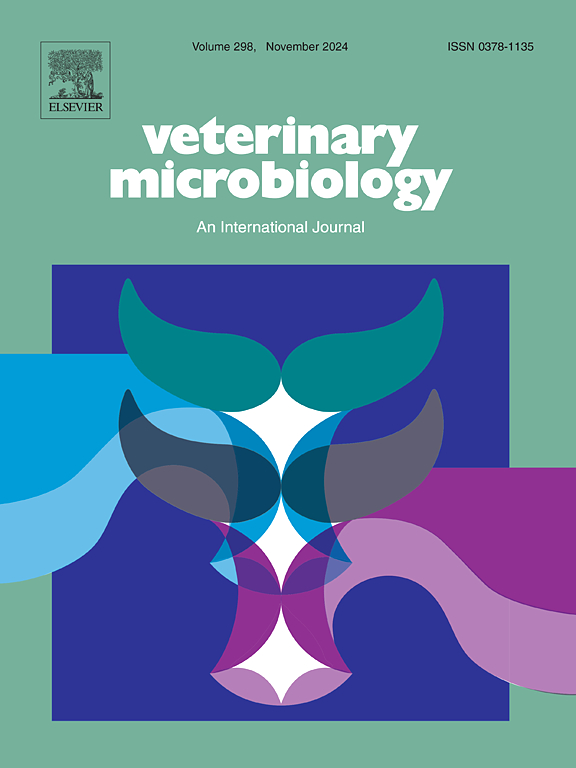FMDV血清型A的两个VP1残基突变通过来自自然宿主的谱系特异性中和抗体揭示的G-H环重定向引起显著的抗原变异。
IF 2.7
2区 农林科学
Q3 MICROBIOLOGY
引用次数: 0
摘要
口蹄疫病毒(FMDV)血清型A表现出广泛的遗传和抗原多样性,使疫苗株选择复杂化。在这里,我们鉴定了两组不同的宿主衍生的SEA97特异性中和抗体(nab)。大多数nab(10/11)靶向抗原位点2,而一种牛源抗体识别VP1 G-H环中的残基138。与A22谱系的A/AF72株相比,T138A的替换和VP1上140 N的缺失显著增强了SEA97谱系特异性抗体对VP1 G-H环和抗原位点2的交叉中和活性,将其覆盖范围扩大到突变的A/AF72株。猪免疫血清中和试验进一步表明,这些突变是A22和SEA97谱系之间抗原差异的关键因素。结构模拟表明,VP1中T138A的取代和140 N的缺失使A/AF72菌株的G-H环构象向SEA97谱系的构象转移,暗示它们是谱系特异性抗原性的分子决定因素。这些发现表明,RGD基序上游极性残基的替换或缺失重塑了G-H环的方向,从而导致了亚洲型FMDV血清型A的抗原变异。本文章由计算机程序翻译,如有差异,请以英文原文为准。
Two residue mutations in VP1 of FMDV serotype A cause significant antigenic variation via reorientation of G-H loop revealed by lineage-specific neutralizing antibodies from the natural hosts
Foot-and-mouth disease virus (FMDV) serotype A exhibits extensive genetic and antigenic diversity, complicating vaccine strain selection. Here, we identified two distinct panels of host-derived neutralizing antibodies (nAbs) specific to the SEA97 lineage. The majority of nAbs (10/11) targeted antigenic site 2, while one bovine-derived antibody recognized residue 138 in the VP1 G-H loop. Compared with the ancestral A/AF72 strain of the A22 lineage, the T138A substitution and 140 N deletion on VP1 significantly enhanced the cross-neutralizing activity of SEA97 lineage-specific antibodies against the VP1 G-H loop and antigenic site 2, extending their coverage to the mutated A/AF72 strain. Neutralization assays with porcine immune sera further demonstrated that these mutations are key contributors to antigenic divergence between the A22 and SEA97 lineages. Structural simulations indicated that the T138A substitution and 140 N deletion in VP1 shifted the G-H loop conformation of A/AF72 strain toward that of SEA97 lineages, implicating them as molecular determinants of lineage-specific antigenicity. These findings suggest that substitution or deletion of upstream polar residues of the RGD motif reshaped G-H loop orientation, thereby contributing to antigenic variation in Asia topotype of FMDV serotype A.
求助全文
通过发布文献求助,成功后即可免费获取论文全文。
去求助
来源期刊

Veterinary microbiology
农林科学-兽医学
CiteScore
5.90
自引率
6.10%
发文量
221
审稿时长
52 days
期刊介绍:
Veterinary Microbiology is concerned with microbial (bacterial, fungal, viral) diseases of domesticated vertebrate animals (livestock, companion animals, fur-bearing animals, game, poultry, fish) that supply food, other useful products or companionship. In addition, Microbial diseases of wild animals living in captivity, or as members of the feral fauna will also be considered if the infections are of interest because of their interrelation with humans (zoonoses) and/or domestic animals. Studies of antimicrobial resistance are also included, provided that the results represent a substantial advance in knowledge. Authors are strongly encouraged to read - prior to submission - the Editorials (''Scope or cope'' and ''Scope or cope II'') published previously in the journal. The Editors reserve the right to suggest submission to another journal for those papers which they feel would be more appropriate for consideration by that journal.
Original research papers of high quality and novelty on aspects of control, host response, molecular biology, pathogenesis, prevention, and treatment of microbial diseases of animals are published. Papers dealing primarily with immunology, epidemiology, molecular biology and antiviral or microbial agents will only be considered if they demonstrate a clear impact on a disease. Papers focusing solely on diagnostic techniques (such as another PCR protocol or ELISA) will not be published - focus should be on a microorganism and not on a particular technique. Papers only reporting microbial sequences, transcriptomics data, or proteomics data will not be considered unless the results represent a substantial advance in knowledge.
Drug trial papers will be considered if they have general application or significance. Papers on the identification of microorganisms will also be considered, but detailed taxonomic studies do not fall within the scope of the journal. Case reports will not be published, unless they have general application or contain novel aspects. Papers of geographically limited interest, which repeat what had been established elsewhere will not be considered. The readership of the journal is global.
 求助内容:
求助内容: 应助结果提醒方式:
应助结果提醒方式:


